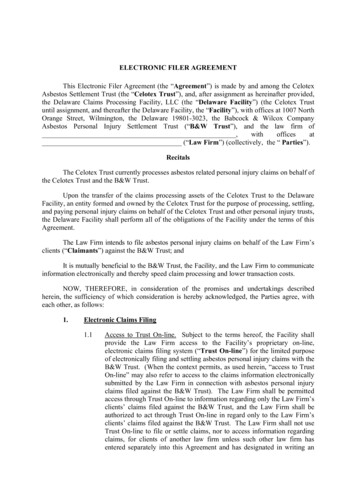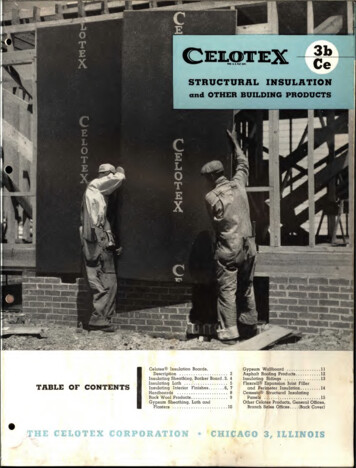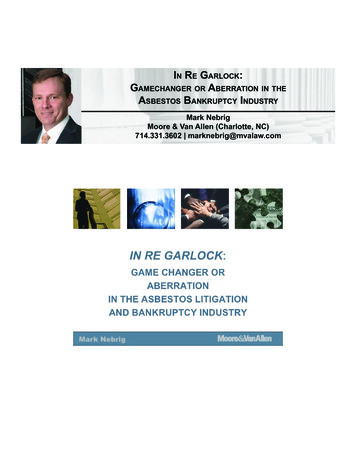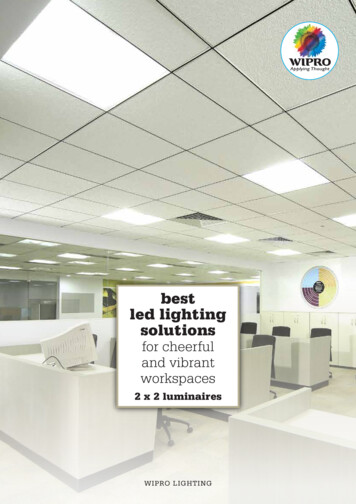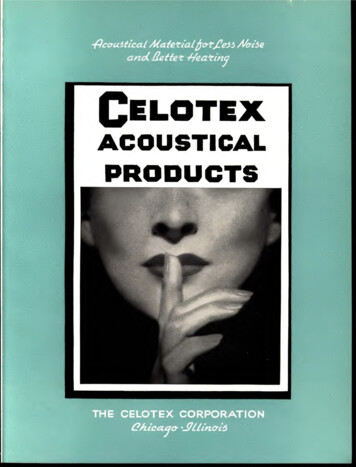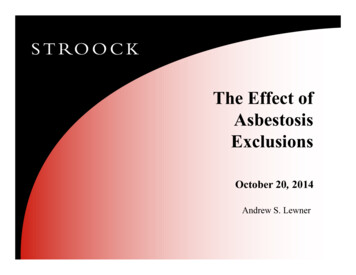
Transcription
Health ConsultationCELOTEX CORPORATIONEDGEWATER, BERGEN COUNTY, NEW JERSEYJANUARY 10, 2007U.S. DEPARTMENT OF HEALTH AND HUMAN SERVICESPublic Health ServiceAgency for Toxic Substances and Disease RegistryDivision of Health Assessment and ConsultationAtlanta, Georgia 30333
Health Consultation: A Note of ExplanationAn ATSDR health consultation is a verbal or written response from ATSDR to a specificrequest for information about health risks related to a specific site, a chemical release, orthe presence of hazardous material. In order to prevent or mitigate exposures, aconsultation may lead to specific actions, such as restricting use of or replacing watersupplies; intensifying environmental sampling; restricting site access; or removing thecontaminated material.In addition, consultations may recommend additional public health actions, such asconducting health surveillance activities to evaluate exposure or trends in adverse healthoutcomes; conducting biological indicators of exposure studies to assess exposure; andproviding health education for health care providers and community members. Thisconcludes the health consultation process for this site, unless additional information isobtained by ATSDR which, in the Agency’s opinion, indicates a need to revise or appendthe conclusions previously issued.You May Contact ATSDR Toll Free at1-800-CDC-INFOorVisit our Home Page at: http://www.atsdr.cdc.gov
HEALTH CONSULTATIONCELOTEX CORPORATIONEDGEWATER, BERGEN COUNTY, NEW JERSEYPrepared By:New Jersey Department of Health and Senior ServicesPublic Health Services BranchConsumer and Environmental Health ServicesHazardous Site Health Evaluation ProgramUnder a Cooperative Agreement with theAgency for Toxic Substances and Disease Registry
Foreword: ATSDR’s National Asbestos Exposure ReviewVermiculite was mined and processed in Libby, Montana, from the early 1920s until 1990. Thisvermiculite, which was shipped to many locations around the United States for processing, isnow known to have contained asbestos.The National Asbestos Exposure Review (NAER) is a project of the Agency for ToxicSubstances and Disease Registry (ATSDR). The project goal is to work with other federal, state,and local environmental and public health agencies to evaluate public health impacts at sites thatprocessed Libby vermiculite.The evaluations focus on the processing sites and on the human health effects that might beassociated with possible past or current exposures. Commercial or consumer use of the productsfrom these facilities is not considered.The sites that processed Libby vermiculite will be evaluated by (1) identifying ways peoplecould have been exposed to asbestos in the past and ways that people could be exposed now and(2) determining whether the exposures represent a public health hazard. ATSDR will use theinformation gained from the site-specific investigations to recommend further public healthactions as needed. Site evaluations are progressing in two phases:Phase 1: ATSDR has selected 28 sites for the first phase of reviews on the basis of the followingcriteria: The U.S. Environmental Protection Agency (EPA) mandated further action at the sitebased upon contamination in place- or The site was an exfoliation facility that processed more than 100,000 tons of vermiculiteore from the Libby mine. Exfoliation, a processing method in which ore is heated and“popped,” is expected to have released more asbestos than other processing methods.The following document is one of the site-specific health consultations that ATSDR and its statehealth partners are developing for each of the 28 Phase 1 sites. A future report will summarizefindings at the Phase 1 sites and will include recommendations for evaluating the more than 200remaining sites nationwide that received Libby vermiculite.Phase 2: ATSDR will continue to evaluate former Libby vermiculite processing sites inaccordance with the findings and recommendations contained in the summary report. ATSDRwill also identify further actions when necessary to protect public health.1
Statement of IssuesVermiculite is a naturally occurring fibrous mineral mined in Libby, Montana, from the1920s until 1990. The vermiculite mined in Libby contained naturally occurring asbestos fibers,including the amphibole varieties tremolite and actinolite, as well as the related asbestiformminerals winchite, richterite, and ferro-edenite [U.S. Geological Survey 2002]. Libbyvermiculite ore collected by EPA in 1980 contained up to 26% tremolite-actinolite by mass[EPA 1982]. Samples of the various grades of unexpanded Libby vermiculite typically shippedto processing sites across the nation contained 0.3%–7% fibrous tremolite-actinolite by mass[EPA 1982]. The characteristic composition of asbestos contained in the vermiculite mined inLibby is referred to in this document as Libby asbestos.Asbestos exposure has been associated with the incidence of asbestosis, lung cancer,mesothelioma, and pleural plaques. Asbestosis is a chronic, degenerative lung disease caused bythe scarring of lung tissue. Mesothelioma, a rare disease, is a cancer of the membranes that linethe chest (pleural) or abdominal (peritoneal) cavities. Asbestos exposure has also beenassociated with lung cancer and, to a lesser extent, gastrointestinal cancers (esophageal, stomach,colon, and rectal). Asbestos exposure may also result in other non-cancerous conditions of therespiratory system such as pleural plaques, which are a thickening of the lining of the lungs (seeAppendix A).EPA has identified seven New Jersey facilities that received vermiculite ore from theLibby mine. This health consultation addresses one of these facilities, the former CelotexCorporation located in Edgewater, Bergen County. Vermiculite was used to manufacturegypsum wallboard at the facility. The process for producing gypsum wallboard at this site usedvermiculite in its unexpanded state and likely released less asbestos than other processes such asexfoliation [EPA 1985].The New Jersey Department of Health and Senior Services (NJDHSS), in cooperationwith ATSDR, prepared a health consultation for the Edgewater site. The main goal of thisconsultation is to evaluate the potential health impact of exposure to Libby asbestos and topropose appropriate actions at the Celotex Corporation site. This health consultation includes: 1)a review of available information on environmental contamination; 2) identification of past,current, and future human exposure pathways of Libby asbestos; 3) characterization of thedegree of public health hazard associated with exposure pathways; and 4) recommendations forhealth-related follow-up activities.2
onmouthOceanAtlantic ermiculite is the common name given tohydrated laminar magnesium-aluminum-iron-silicate, amineral that resembles mica in appearance. Allvermiculite ores contain other minerals, and some sourcesof the ores have been found to contain asbestos fibers.Vermiculite mining is a surface operation where ore isseparated from other minerals and then screened orclassified into several particle sizes. Althoughvermiculite is found in various parts of the world, thecurrent predominant commercial mines are in Australia,Brazil, China, Kenya, South Africa, United States, andZimbabwe.In the 1920s, the Zonolite Company was formedAtlanticCumberlandand began mining vermiculite ore in Libby, Montana.CapeThe mine was later sold to W.R. Grace & Company andMaywas finally closed in 1990. While in operation, thevermiculite mine in Libby may have produced 80% of theFigure 1: Location of Celotexworld's supply of vermiculite [EPA 2005]. Because allCorporation Sitevermiculite does not contain asbestos, it has been used asloose fill insulation, fertilizer carrier, and aggregate for concrete. Raw vermiculite ore is used ingypsum wallboard, joint compound, and cinder block, as well as in many other buildingproducts.EPA requested that ATSDR provide technical assistance in evaluating the potentialpublic health impacts from Libby asbestos. In New Jersey, the former Celotex Corporation inEdgewater, Bergen County, used vermiculite mined in Libby, Montana, to produce gypsumwallboard (see Figure 1). Although the site was the location of numerous industrial operationsthroughout the years, this health consultation focuses exclusively on the gypsum wallboardmanufacturing activities and on an on-site landfill used primarily for gypsum wallboard wastedisposal.Available records indicate that the Celotex Corporation received and processedapproximately 300 tons of vermiculite from the Libby, Montana, mine during 1967 through 1969and did not perform exfoliation as part of their operation [ATSDR 2002a]. ATSDR selected theCelotex Corporation as one of the 28 Phase 1 sites because it had been designated by EPA as a“Further Action Site” [A. Gonzalez, ATSDR, personal communication, 2003].3
Site DescriptionThe Celotex Corporation site, hereafter referred to as the “Celotex site”, is located at 1River Road, Edgewater, Bergen County, New Jersey (see Figure 2). The 29.5 acre site is in amixed industrial-, commercial-, and residential-zoned area. The site is bordered on the west by“new” River Road. Beyond River Road is residential housing that overlooks the site from atopthe New Jersey Palisades cliffs at a distance of approximately 500 yards. The site is bordered onthe northwest by Multiplex Cinemas; to the north by Independence Harbor, a residentialwaterfront development of approximately 500 units; on the east by the Hudson River; and on thesouth by the Quanta Resources Corporation site [ATSDR 2002b]. The Quanta ResourcesCorporation site, a former coal tar distillation operation, was added to the National Priorities Liston September 4, 2002. An aerial view of the Celotex site is presented in Figure 3.In the 1990s, the eastern portion of the Celotex site was redeveloped for residential useand The Promenade (see Photograph 1) was constructed. The Promenade consists of 162 unitsof condominiums and apartments and is located on an 800 foot pier extending into the HudsonRiver. Recently, a multi-story residential and commercial development named “City Place” wasbuilt on the western portion of the Celotex site. City Place spans five square blocks along theHudson River waterfront and contains 331 apartments and street-level retail businesses.ATSDR, using U.S. Census 2000 data, estimates that approximately 37,000 individualsreside within a 1-mile radius of the Celotex site (see Figure 4); in the decade prior, nearly 30,000individuals resided within a 1-mile radius of the site.Site HistoryIn spite of an extensive review of available the NJDEP files on the Celotex site (i.e., siteremediation, air enforcement, and solid and hazardous waste files), no specific information ordocumentation could be found on employee records or on the gypsum wallboard manufacturingoperation.The Celotex Corporation acquired several facilities from Allied Chemical Corporationaround 1970 ( /- 5 years) that included the gypsum wallboard manufacturing operation locatedin Edgewater (L. Colburn, Celotex Corporation, personal communication, 2002). AlliedChemical Corporation1 manufactured gypsum wallboard for a number of years before theCelotex purchase. “Off-spec” gypsum wallboard products produced at the Celotex site weredumped in an on-site landfill. In the late 1970s, the Celotex Corporation transferred its gypsum1Allied Chemical Corporation changed its name to Allied Corporation in 1981 and merged with the SignalCompanies to form AlliedSignal in 1985. In 1999, AlliedSignal and Honeywell, Inc. announced a merger agreementto form Honeywell. Information concerning the AlliedSignal gypsum wallboard manufacturing operation,vermiculite transport, employee records, off-site use of vermiculite, and disposal practices is unavailable (M.Kamilow, Honeywell, personal communication, 2002).4
wallboard manufacturing operation to another location and began leasing the Edgewater propertyto other industries (R. Hayton, NJDEP, personal communication, 2002). During this time, thearea along the Hudson River in Edgewater was heavily industrialized, and, according to theNJDEP, it was common practice for companies to exchange waste products and soil for use asfill material.Vermiculite at the Celotex site was used as purchased, i.e., no exfoliation occurred at theEdgewater facility (L. Colburn, Celotex Corporation, personal communication, 2002).Exfoliation is the rapid heating of vermiculite at temperatures above 1,000 degrees Fahrenheit(oF). An oven process was used at the site to cure the vermiculite at a low temperature (around200oF). Typically, vermiculite is added to gypsum wallboard to improve its structural integrityduring a fire [Georgia-Pacific 2005]. Vermiculite has several properties that make it importantfor fire protection when it is used in sheetrock (J. Wheeler, ATSDR, personal communication,2006). It has very low heat conductivity, and expands and fills voids thus preventing burnthrough. The water contained in it becomes steam and absorbs heat. Fire retardant sheetrockmade when Celotex was in operation, used asbestos as a structural component and flameretardant (vermiculite was added as a second agent). This addition of vermiculite to the gypsumwallboard is probably the major source of on-site chrysotile asbestos. The gypsum wallboardmanufacturing process was described as a not especially dusty operation since the raw material(gypsum) was fairly moist. Dust was generated, however, when the gypsum wallboard was cutand sized. The number of individuals employed by the Celotex gypsum wallboardmanufacturing operation is not now known. In 2000, BPB America, Incorporated, purchased theCelotex gypsum wallboard and ceiling tile businesses. Celotex is still in operation, although itdoes not have a plant facility.Soil ContaminationOn-Site Landfill. As part of the waterfront development permit for City Place, a stormwater detention basin was required for the collection of on-site surface water runoff (seePhotograph 2). Construction of this basin required the reconfiguration of the 2.8 acre on-sitegypsum wallboard landfill, and a Major Landfill Disruption Permit application was submitted tothe NJDEP. Borings installed in the landfill identified the presence of contaminants (e.g., lead,arsenic, and polychlorinated biphenyls [PCBs] at subsurface depths; boring samples were notanalyzed for asbestos. Samples collected from the surface of the landfill indicated “noactionable asbestos present” [EWMA 2001]. Based on the analytical data collected, the use ofinstitutional (deed notice) and engineering controls (surface cap to restrict exposure of the wastematerial) were deemed to be the appropriate and recommended remedial approach for the landfill[EWMA 2000]. The permit application was approved by the NJDEP in September 1999.In reshaping the landfill to accommodate the construction of the storm water detentionbasin, the volume of excavated waste material generated exceeded the expected volume bynearly sixfold. The waste was bulldozed westward toward River Road and was pushed into anapproximately 20-foot high pile. Workers began grading the top of this pile, but it was too high.The landfill was then expanded to the west and onto the City Place construction site. This waste5
was covered with soil and remained in this state for several years. Plans to bulldoze the soilfrom the west side eastward to meet and complete a 15-foot high pile of waste from the originallandfill were not approved by the NJDEP. Ultimately, nearly 6,000 tons of waste from thewesternmost portion of the landfill was excavated and transported to the Linden solid wastelandfill pursuant to the NJDEP requirements [EWMA 2002; Monteclavo 2001]. Results of airmonitoring conducted at four locations along the perimeter of the landfill throughout the Octoberand November 2001 excavation period were negative for arsenic, cadmium, chromium, and lead;no monitoring or analysis was conducted for asbestos [Turner 2001]. In anticipation of potentialodor problems, the residents of The Promenade were notified about the excavation a week beforethe work began [Heller 2001].In a letter from the NJDEP to the developer (Edgewater Enterprises LLC), the followingproblems concerning the landfill were outlined: 1) the landfill was expanded beyond the originalboundaries as described in the landfill disruption permit application; 2) the landfill was notuniformly covered with the required 24 inches of clay (coverage ranged from no cover to 24inches), with some landscape plantings placed directly in waste material; 3) paver blocks used inthe construction of the river walkway were laid directly on waste material; and 4) a pile of wastematerial was left uncovered on the western portion of the landfill [Hayton 2000]. Site visitsconducted by the NJDEP in early 2001 determined that the majority of the public river walkwaywas constructed with insufficient underlying cap (i.e., paver blocks resting on six inches or lessof dense-graded aggregate and two inches of leveling sand); some paver blocks were laiddirectly onto waste. This situation was further substantiated by field investigations conducted inDecember 2001 and January 2002, in which portions of the remaining landfill, particularly areasnear a sidewalk and public walkway, did not have the required cap thickness [EWMA 2002]. Aportion of the public walkway along the Hudson River has been completed and may becontinued as part of future area redevelopment activities designed to establish a continuous 18mile public waterfront extending from the George Washington Bridge to the Bayonne Bridge[Fund for a Better Waterfront, Inc. 1999].On April 4, 2000, EPA representatives collected 12 discrete grab surface soil samples ofexposed material and surface soil from the landfill (see Photograph 3). The samples wereanalyzed for asbestos content using polarized light microscopy (PLM) and transmission electronmicroscopy (TEM) (see Appendix B)2. The PLM results indicated that the asbestosconcentration in samples 1 through 11 were below detection level. Sample 12, which contained25% chrysotile asbestos, was collected from a pile of demolished building debris on theabandoned pier (see Figure 5). The material appeared to be crumbled pieces of transite sidingboard [ATSDR 2002a]; the asbestos content of this sample was not considered representative ofthe waste material in the landfill.2PLM does not distinguish between asbestos and other types of fibers and counts only fibers longer than fivemicrometers. It is typically used for determining the asbestos content of bulk samples such as soil or pipe insulation;results are reported in percent (%). TEM can distinguish asbestos from other fibers and is also able to detect verythin fibers less than 0.01 µm in diameter. The analytical technique known as energy dispersive X-ray spectrometry(EDXA) is used with TEM to confirm the identity of fibers.6
The TEM results indicated that only one sample (sample 11) of the surface soil samplescontained actinolite asbestos structures (see Table 3). Although actinolite was widely reported[USGS 2002] as one of the asbestos fibers found in the Libby asbestos, recent data [Leake et al.1997; Meeker 2003] indicated that actinolite fibers are not one of the amphibole asbestos fibertypes characteristic of Libby asbestos. On the basis of these results, the EPA required no furtheron-site activities.Site VisitOn September 25, 2002, a site visit was conducted at the Celotex site, Edgewater, BergenCounty. Present during the site visit were James Pasqualo, Steven Miller, and Julie Petix of theNJDHSS and Kathryn Lynch, Susan Metcalf, and Amanda Gonzalez of the ATSDR. TheNJDEP Case Manager for the site was present and provided a tour and overview of siteconditions.The gypsum wallboard landfill, located south of The Promenade pier was covered withpaver blocks. A staffed guardhouse for The Promenade was centrally located on the landfill(Photograph 4). Heavy construction activity (i.e., pouring concrete) was occurring directly westof the landfill as part of City Place development activities. According to the NJDEP, workerswere required to wet the site at least three times a day for dust suppression. Perimeter airmonitoring for non-asbestos-related contaminants was continuing at that time.On April 28, 2005, a second site visit of the former Celotex Industrial Park site wasconducted. Present were Steve Miller, Tariq Ahmed, and Somia Aluwalia of the NJDHSS; LeahEscobar of the ATSDR; and a representative from the NJDEP. The NJDEP representative statedthat the developer of the site planned to construct seven buildings, six of which were alreadybuilt. At the time of the site visit, construction on Building 7 was underway.The former gypsum wallboard landfill area was inspected during this site visit.According to the NJDEP representative, the cap thickness on the landfill was compromised in afew places and was evident by the stressed vegetation and the settlement of some pavementblocks. When asked about the dust levels reported by The Promenade residents duringremediation of the landfill, the NJDEP representative stated that Environmental WasteManagement Associates (EWMA) had used water spraying as a dust suppression measure andwas unaware of any excessive dust issues.Past ATSDR InvolvementAs part of the Public Health Assessment for the Quanta Resources Corporation site, theNJDHSS, in conjunction with the ATSDR, reviewed and analyzed environmental data collectedfrom the Quanta site and from neighboring properties, including the Celotex site [ATSDR2002b].7
Community ConcernsAccording to the NJDEP, a common community concern regarding the Celotex siteinvolves rotten egg odors that result from gypsum wallboard debris coming in contact with riverwater.In October 2002, the NJDHSS received a telephone call from a former Cliffside residentwho was concerned about a variety of cancers, including lung cancer, experienced by thisindividual and several of his family members. This individual stated that during the years of itsoperation, the Celotex plant constantly emitted dust that had an odor comparable to rotten eggs.Also in October 2002, the NJDHSS received a telephone call from an individual onbehalf of her spouse. In the mid-1980s, the spouse was employed as a security guard and wasstationed in a “telephone booth-type” structure located outdoors near the entrance to the Celotexsite. The spouse, who was in his mid 50s and who had never smoked, was reportedly diagnosedin August 2001 with “asbestos pleural disease which may develop into mesothelioma”.In December 2003, a former resident of The Promenade petitioned the ATSDR about theredevelopment of the Celotex site. Her concerns included exposure to dust from on-siteconstruction activities during the time of her and her spouse’s residency (2000–2003) and thepotential impact of this exposure on their health. The petition was accepted, and a separatehealth consultation is being prepared to address these concerns.Worker InterviewsIn an effort to identify and contact former employees, the NJDHSS requested theassistance of an Edgewater Borough Health Department public health nurse who was able toprovide the name of one of the former employees. The individual was employed as a lineforeman from the time the Celotex Corporation purchased the gypsum wallboard operation fromAllied Chemical Corporation until the Edgewater plant closure in 1978 or 1979. Through atelephone interview, the former employee provided the following description of the gypsumwallboard manufacturing process: the gypsum came in as rock on ships from Nova Scotia and was ground to powder on-site(this process was described as “dusty”);the vermiculite was shipped to Celotex in bags loaded on skids on flatbed trucks, and thebags were stored uncovered on-site;(non-exfoliated) vermiculite was added to a slurry of gypsum powder, water, and “flour”;the bags of vermiculite were cut open, and, as needed, the vermiculite was added to hoppersthat contained slurry;8
the slurry was de-watered and processed by papering it on 500-foot long belts;the product was then heated in a kiln at 550oF, then at 350 oF, and was followed by cooling at250oF; andair scrubbers were used to minimize dust emissions.According to this former employee, disposal practices consisted of dumping wastebehind the plant along the Hudson River, which eventually modified the original shoreline. Theair scrubbers sometimes broke down, leading to complaints from neighboring residents as theirhomes became coated with fine dust. This dust was “only gypsum powder” because thevermiculite had not yet been added to the process. Showers were provided on-site andemployees did not wear their work clothes home, or, at least, this former employee did not.DiscussionDuring the period 1967 through 1969, vermiculite processed at the Celotex siteoriginated from the mine in Libby, Montana, known to be contaminated with asbestos. Studiesconducted in the Libby community indicate health impacts that are associated with asbestosexposure [ATSDR 2002c; Peipins et al. 2003]. The findings at Libby provided the impetus forinvestigating sites across the nation that received asbestos-contaminated vermiculite from theLibby mine. Asbestos exposure conditions documented in the Libby community, however, arein many ways unique and not necessarily present at other sites that processed or handled Libbyvermiculite. The health consultation prepared for the Celotex site is part of a national effort toidentify and evaluate potential asbestos exposures that may be expected at the sites thatprocessed or handled Libby vermiculite.Exposure Assessment and Toxicologic EvaluationAn evaluation of the health effects of exposure to Libby asbestos requires extensiveknowledge of both exposure pathways and toxicity data. The toxicologic information currentlyavailable is limited, and, therefore, the exact level of health concern based on the different sizesand mineral types of asbestos remains controversial (see Appendix A). Site-specific informationon exposure pathways is also limited or unavailable. The limitations include the following: No information could be obtained about past levels of asbestos in the air in and around thesite. This lack of information hinders our ability to estimate the levels of Libby asbestos thatindividuals may have been exposed to. No information is known about the frequency of people’s contact with Libby asbestos fromthe site. This information is necessary to accurately calculate exposure doses.9
Insufficient information is available on the handling and disposal of wastes containingvermiculite. This lack of information makes identifying and assessing past and presentpotential exposures difficult.Given these limitations, the public health implications of past operations at this site wereevaluated qualitatively. Current health implications were likewise evaluated qualitatively.The following sections describe the various types of evidence used to evaluate exposurepathways and reach conclusions about the site. In the health consultation, ATSDR considers aset of relevant pathways (see Appendix C) and evaluates those pertaining to the Celotex site andto Libby asbestos (see Table 1). Not every pathway identified in Appendix C was considered tobe a significant source of exposure at the site. The exposures associated with the chrysotileasbestos detected at the site will be addressed in a separate health consultation.Exposure PathwaysCompared with other Phase 1 sites that received vermiculite shipments from W.R. Grace,a relatively small amount (300 tons) of vermiculite from Libby, Montana, was shipped to andused at the Celotex site. Because exfoliation did not occur at the site, workers’ occupationalexposures to Libby vermiculite were reduced, as were community members’ potentialenvironmental exposures. Those exposed to asbestos were the former Celotex site workers whohandled Libby vermiculite (1967–1969) in the course of their work duties, and they may havebrought dust containing asbestos home on their clothing, shoes, and hair and in theirautomobiles. One former employee stated that on-site showers were available, which, if used,would have reduced the amount of Libby vermiculite dust brought home.The area of the former Celotex site has been redeveloped for commercial and residentialuse. Construction activities associated with The Promenade and City Place disturbed site soils,including the on-site landfill that contained gypsum wallboard waste, and created dust. Thesampling results indicated that although half of the samples contained chrysotile asbestos (seeAppendix B), the amphibole asbestos fiber types characteristic of Libby asbestos were notpresent.10
Table 1: Libby Asbestos Inhalation Pathways Considered for the Celotex Corporation SitePathwayNameExposure eOccupationalFormer Celotex Corp. workers exposed toairborne Libby asbestos during handling andmanufacturing of gypsum wallboardHouseholdContactHousehold members exposed to airborneLibby asbestos brought home on CelotexCorp. workers’ body or clothingPotentialNotapplicableNotapplicableWaste PilesCommunity members disturbing on-site wastepilesPotentialEliminatedEliminatedOn-site SoilsCurrent on-site workers, contractors, orcommunity members disturbing contaminatedon-site soils (residual contamination, buriedgypsum wallboard manufacturing waste)Community members and nearby workersexposed to Libby asbestos fibers from facilityemissions during gypsum wallboardmanufacturing ntialNotapplicableNotapplicableCommunity members and workers
Figure 1: Location of Celotex vermiculite does not contain asbestos, it has been used as Corporation Site loose fill insulation, fertilizer carrier, and aggregate for concrete. Raw vermiculite ore is used in gypsum wallboard, joint compound, and cinder block, as well as in many other building products.

